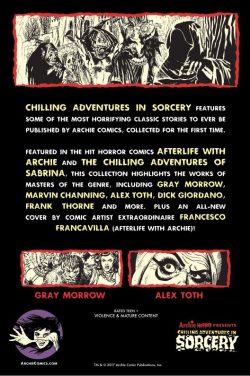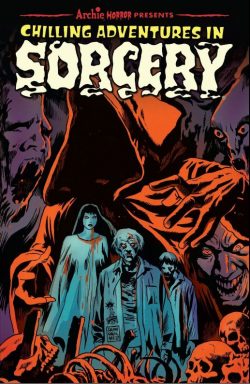

By Harry Doyle, Gray Morrow, Marvin Channing, Don Glut, Steve Skeates, Mary Skrenes, Carol Seuling, Phil Seuling, Larry Hama, Bob Holland, Stan Goldberg, Vicente Alcazar, Dick Giordano, Carlos Pino, Dan DeCarlo, Howard Chaykin, Alex Toth, Bruce Jones, Ed Davis, Frank Thorne & various (Archie Comics)
ISBN: 978-1-62738-990-7 (TPB)
Win’s Christmas Gift Recommendation: Shockingly Wicked Chronicle of Chills… 9/10
For nearly 8 decades Archie Comics have epitomised good, safe, wholesome, fun but the company has always been a surprisingly subversive one. Family friendly – and not – iterations of superheroes, spooky chills, sci fi thrills and genre yarns have always been as much a part of the publisher’s varied portfolio as the romantic comedy capers of America’s cleanest-cut teens.
As you probably know by now, the eponymous Archie has been around since 1941, but the publisher has other wholesome stars – such as Sabrina the Teenage Witch or Josie and the Pussycats – in their stable, almost as well known… and just as prone to radical reinterpretation.
To keep all that accumulated attention riveted, the company has always looked to modern trends with which to expand upon their archetypal storytelling brief. The contemporary revival in horror across all media has thus resulted in a few supernatural sidebar titles such as Afterlife with Archie and Jughead: The Hunger.
Moreover, in times past the publisher have cross-fertilised their pantheon through such unlikely team-ups as Archie Meets the Punisher, Archie Vs Sharknado and Archie Vs Predator, whilst every type of fashion fad and youth culture sensation has invariably been accommodated into and explored within the pages of the regular titles.
Following-up the stunning success of aforementioned zombie apocalypse Afterlife with Archie, they took another boldly controversial step: radically reinventing their saccharine-TV teen witch in astoundingly sophisticated Chilling Adventures of Sabrina after playwright, screenwriter and comics scribe Roberto Aguirre-Sacasa (whose many hits include The Mystery Plays, 4: Marvel Knights Fantastic Four, Stephen King’s The Stand and Afterlife with Archie amongst others) pitched the idea to re-imagine the saucy sorceress in terms of Rosemary’s Baby and The Exorcist.
Archie Comics was no stranger to such material. In the 1970s the company created sub-imprint Red Circle for anthology terror tales during a previous supernatural boom time, before gradually converting the line to superhero features as the decade progressed and the fad faded. They even had resident witch-girl Sabrina narrating Chilling Tales of Sorcery for the first two issues…
The title dropped subhead “…As Told by Sabrina†for #3, and with #6 (April 1974) became Red Circle Sorcery until folding in February 1975’s issue #11.
In a great example of circularity, the newly-wicked 21st century Sabrina features snippets from the ’70’s anthology, sparking this edgy compilation of many of those lost classics in a spiffy monochrome collection, available in paperback and digital formats.
Following a fervent Introduction by letterer and fright-fan Jack Morelli, the vintage terrors open with Chilling Tales of Sorcery …as Told by Sabrina #1 (September 1972): a rather standard anthology of short thrillers with twist-endings, little different from those churned out by DC, Gold Key or Charlton at the time and crafted by Archie’s on-staff comedy creators.
‘Behold the Beast’ by Frank Doyle & Stan Goldberg, revealed the fate of a lonely and misunderstood deformed lad, after which ‘The Boy Who Cried Vampire’ (Doyle & Dan DeCarlo) deals out ironic justice to a pesky kid and ‘Assignment in Fear’ (Doyle & DeCarlo) sees a teacher with a secret sort out a class bully in horrific style.
Anonymous prose yarn ‘A Real Hot Talent’ gets under the skin of a juvenile firestarter after which Doyle & DeCarlo return to exhibit ‘Quick Justice’ in an art gallery before Doyle & Goldberg reveal how ‘Curiosity Kills’ in a story of an accursed inheritance.
Issue #2 opens with Doyle & Goldberg’s ‘The Ultimate Cure’ wherein a waiting bride’s tragic misapprehension destroys her man and her sanity, and text tale ‘Look Upon Your Legacy’ warns of the dangers of an over-active imagination. Pictorial perils resume with ‘Sonny’s World’ (Doyle & Dan DeCarlo) with a little brat learning how to make all reality his plaything after which ‘The Measure of a Monster’ Doyle & Goldberg) sees mad science unleash a colossal creature and (almost) find a safe conclusion and the same creators outline the fate of a jewel-obsessed lass succumbs to ‘The Cameo’s Curse’…
A massive shift in style and tone began with issue #3 (October 1973) as writer/artist Gray Morrow came aboard, personally crafting or supervising far more mature fare that seemed closer to Warren’s adult horror magazines than contemporary newsstand fare such as House of Mystery, Ghostly Haunts or Boris Karloff Tales of Mystery.
Dwight Graydon “Gray†Morrow was born in Fort Wayne, Indiana in 1934 and studied at the Chicago Academy of Fine Arts. After serving in the army he moved to New York City in 1955 and began a steady career contributing strips, covers and illustrations to Cracked, Classics Illustrated, Atlas Comics (pre-Marvel), numerous children’s books and pulps such as Galaxy.
A master of graphic realism, his art and stories graced a vast array of comics titles, magazines such as Space: 1999 and alternative vehicles such as Wally Wood’s Witzend. He freelanced for dozens of companies (he co-created DC’s El Diablo and Marvel’s Man-Thing, and revamped Archie’s Black Hood into a gritty urban avenger during his tenure at Red Circle), as well as drawing the newspaper iterations of Tarzan and Buck Rogers. He won numerous awards – including three Hugos – over a long and extremely wide-reaching artistic life. He died in 2001.
His influence on the title was instantaneous. With the imprint renamed Red Circle Comics for the third (almost all-Morrow) issue, the new chief introduced a growing band of fresh writers and master artists, as the title unleashed a wave of terror tales that owed much to movies and TV of the period.
It began with ‘…Cat’ (written, drawn & lettered by Morrow) wherein a ruthless, misogynistic society burglar targets the wrong gem-bedecked senorita and lives to regret it forever.
Following prose thriller ‘A Stab in the Dark’ – exposing a plot to murder by witchcraft – a thematic diversion into EC-tinged science fiction finds a time traveller accidentally become an evolutionary ‘Missing Link!’ whilst a bereaved man investigates the death of a sister and discovers that a new ‘Immortality Factor’ is anything but.
An embezzler then pays the price for his betrayal in ‘Haunted Gallery’ before the issue closes with fact-page ‘Essays into the Supernatural’: a featurette by Phil Seuling & Morrow exploring timeless rituals of magic and the use of ‘Familiars’…
Due to his prestige and sheer artistic quality, Morrow could call upon a lot of high-end associates to fill pages and #4 (December 1973) introduced an internationally famous master of mood as Spaniard Vicente Alcazar (Jonah Hex, Commando Picture Library, Star Trek, Space: 1999) began his association by writing and illustrating ‘Suicide… Maybe’: a saga of Faustian tragedy wherein a lifelong failure makes a fool’s bargain and discovers politics is the Devil’s playground…
Text vignette ‘Loophole’ also explores such contracts before Don Glut & Dick Giordano highlight the ‘Horripilate Host’ whose TV show excesses lead to infernal doom, after which Morrow adds a sinister tweak to the legend of Midas when a greedy creep gains the legendary ‘Golden Touch!’
The power of a Hebrew Golem deals poetic justice to a modern oppressor in ‘A Thousand Pounds of Clay’ by Glut & Alcazar before the issue ends with another fictive factoid as ‘Essays into the Supernatural’ finds Morrow exploring truths and fictions of ‘The Witch’…
Cover-dated February 1974, #5 opens with a vivid pastiche of Arabian adventure courtesy of writers Morrow and Larry Hama. Limned by Alcazar ‘The Two Thieves of Baghdad’ exposes the fatal flaw of overconfidence before the all Alcazar ‘Esme’ details the fate of a hit-&-run victim whose vision is horrifically enhanced by her accident.
Morrow brings his lifelong affinity for baroque, barbaric science fantasy to the creepy epic ‘Barometer Falling…’ after which Alcazar’s ‘The Choker is Wild’ reveals the shocking history of blood-drinking sovereign Queen Maleena and the ‘Essays into the Supernatural’ featurette – by Seuling & Morrow – catalogues the totemic value of ‘Dragons’.
Red Circle Sorcery #6 (April) opens with ‘Warrior’s Dream’ by Steve Skeates, Mary Skrenes & Morrow as a lusty barbarian finally pays the price for all that wenching and, following an ‘Essays into the Supernatural’ page detailing legends of ‘The Werewolf’ (by Marvin Channing & Morrow), sees a conjuring upstart destroyed by a sagacious warlock in ‘Out of Practice’ by Seuling & Ed Davis.
British comics stalwart Carlos Pino was Alcazar’s studio partner for years (often collaborating as “CarVicâ€) and here he solos in Channing’s tale of vengeance-by-witchcraft ‘Death Goes to a Sales Convention!’, before Carol Seuling & Howard Chaykin go full medieval in epic saga of demonic manipulation and feline vengeance ‘The Patience of a Cat’…
Futuristic sensory-inundation tech is the driving force in T. Casey Brennan’s extended prose mystery ‘Black Fog’ – illustrated by Morrow – after which Channing & Alcazar serve out just deserts to a serial womaniser in ‘Face of Love – Face of Death’ to close the issue.
Red Circle Sorcery #7 commences with ‘A Twist in Time’ by Skeates & Pino as an ancient wizard is drawn into Fate’s plan to punish a modern-day murderer after which Channing & Morrow explore legends of ‘The Dibbuk’ in another gripping ‘Essays into the Supernatural’ featurette before Channing & Alcazar memorably reveal the dangers of owing ‘The Knife of Jack the Ripper’…
Channing scripts a rare but welcome artistic foray for Bruce Jones as ‘The Rivals’ follows two kids from mid-western poverty to dizzying heights and their grim, witchcraft assisted ends after which Brennan & Alcazar showcase the frustrating fate of ‘The Benefactor’ nobody will listen to…
Closing the chronological portion, ‘Essays into the Supernatural’ then offers a featurette by Morrow detailing ‘Possession and Exorcism’ which happily leads not to the end, but rather a selection of Bonus Stories from later issues.
From #9 (October 1974) comes ‘…If I Were King’ by Channing & the magnificent Alex Toth, wherein a meek nobody gets his greatest wish fulfilled – with the usual regrets – before #8 (August 1974) offers a compelling ‘Essays into the Supernatural’ featurette by Channing & Frank Thorne, detailing the tricks of pesky ‘Poltergeists’ and closure via illustrated calligraphic ode ‘The Spectre’ by Bob Holland & Morrow.
The company’s recent resurgence on TV and in the comics has seen a variety of alternate iterations of the timeless pantheons and this no-frills massively monochrome trade paperback (or digital download) is a perfect complement to those aforementioned horror-tinged titles.
Please don’t be put off by the black-&-white reproduction here: these tales are crafted by masters of line art and tonal values and their efforts actually benefit from the subtraction of the cheap colour used in the original releases. These are superb voyages into the bizarre unknown that no lover of dark fiction should miss.
© 2017 Archie Comic Publications, Inc. All rights reserved.
